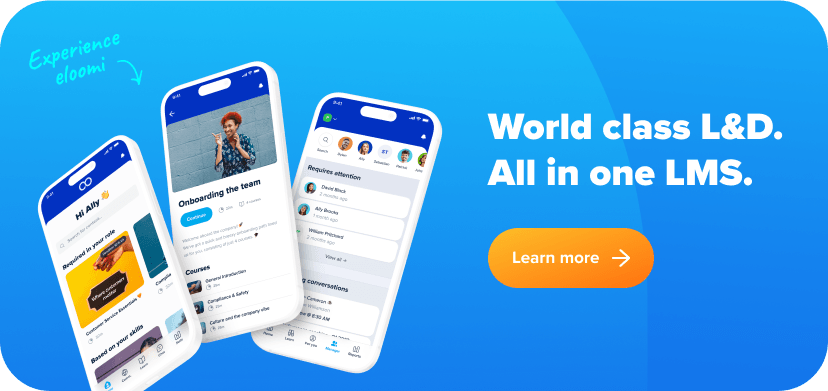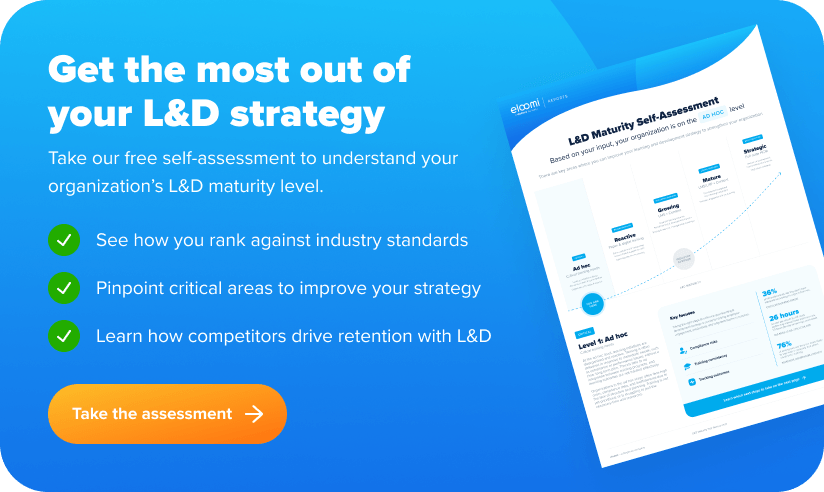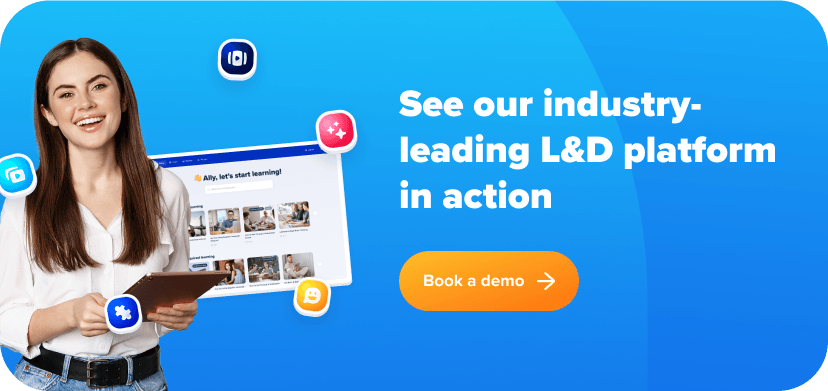What is an LMS (Learning Management System)?
Did you know that about 90% of learners prefer online over traditional learning? Businesses are seeing the same trends, and with the rise of hybrid work, Learning Management Systems (LMS) and Learning Experience Platforms (LXPs) are stepping in to help HR deliver exceptional employee training and boost employee development, no matter where your workers are. To better understand how LMSs are key in employee development, let’s explore first what an LMS is and what are its key features and benefits.
An LMS is a smart cloud-based learning management system that empowers organizations to train and develop their workforce effectively. It offers a comprehensive set of LMS features that assist organizations in creating, delivering, and tracking e-learning courses seamlessly. Learn more about the whole learning management system from our complete guide to LMS.
Digital learning platforms like eloomi are constantly evolving from traditional e-learning methods. eloomi is an L&D platform that combines the best features of an LMS together with LXP innovations to streamline the delivery and management of online training programs, while empowering employees to get the most out of their learning and development paths. So, how does it work, and what are the key features of an LMS?
eloomi LMS key features
Employee development training is made easy with eloomi LMS; let’s explore some of the key features of an LMS provided by eloomi that distinguish it from other LMS platforms.
Easy user-friendly interface
eloomi is an online learning management system that has a user-friendly interface which allows users to easily navigate and utilize the platform. Its intuitive dashboard provides an overview of the courses and their progress, enabling users to efficiently manage their e-learning programs.
Customizable LMS course creation
eloomi’s LMS offers a customizable course creation feature that allows organizations to create and design courses tailored to their specific needs. The platform provides a variety of multimedia tools, such as videos, images, and quizzes, that can be integrated into the course. This feature enables organizations to create engaging and interactive courses that cater to the diverse learning styles of their employees.
Automated notifications to users
Our corporate LMS sends automated notifications to users, informing them about upcoming courses, deadlines, and other essential information. This feature helps users (and managers) stay on track and ensure courses are completed on time. Automated notifications ensure that users are aware of their course progress and deadlines, preventing any delays in LMS course completion.
Advanced analytics and reporting
This learning management system provides advanced analytics and reporting features that allow organizations to monitor the progress of their e-learning programs. It offers insights into user engagement, completion rates, and course effectiveness, enabling organizations to make data-driven decisions. Analytics and reporting features assist organizations in identifying areas for improvement and making necessary changes to enhance the effectiveness of their e-learning programs.

Full mobile compatibility
eloomi’s corporate LMS offers full mobile compatibility, allowing users to access courses on the go. This feature enables employees to learn anytime, anywhere, providing them with the flexibility to balance their work and learning. Mobile compatibility ensures that employees do not miss out on their training, even if they are not in the office.
Highly ensured security
eloomi also follows key security measures, with data storage and 24/7 cloud hosting via ISO certified Microsoft Azure, as well as secure logins and data protocols to improve security. It guarantees your ability to safeguard user data and keep information secure and protected, even while training thousands of employees, customers and partners, and giving organizations peace of mind when using the LMS platform.
Full integration with other systems guaranteed
eloomi can easily be integrated with other systems such as HRMS and CRM. Our one-click integrations support 40+ of the most popular HR tools, so you can keep records up to date without the frustration of manual data entry. Integration with other systems helps organizations streamline their processes and ensures that all employee data is consolidated in one place, which means you can manage your LMS training programs more efficiently and effectively.
Dedicated customer support
eloomi provides customer support via email, phone, and chat. Our dedicated support team is always available to assist you with any queries or issues you may have. This ensures that you can reach out for help whenever you need it, so you can spend more time on the tasks that matter.

What is an LMS (Learning Management System)?
Another common question is why an organization needs a learning management system and who benefits from it. The answer is simple: everyone. Every learner and employee can benefit from an LMS, but more importantly, any business can significantly enhance employee development, retention, and productivity through LMS skills training.
How? Adopting a digital and innovative LMS like eloomi allows your company to leverage your workforce’s skills and identify training needs efficiently. The crucial question isn’t who needs an LMS but rather what kind of training each individual requires. With a digital system like eloomi, tracking employee performance and identifying skill gaps becomes seamless within a single solution.
Organizations can equip their employees with a powerful tool that supports and empowers them in various learning situations while gathering valuable insights to refine and tailor their training programs. In today’s fast-paced business environment, all sectors need robust and rapid employee development methods to ensure compliance and maximize potential. Managers, especially those overseeing remote teams, require a structured approach to training.
An LMS enables you to create and distribute learning content efficiently, reach all team members, and send automated reminders effortlessly. Subject matter experts can make a more significant impact on learners, maximizing the benefits of the training. In summary, an LMS is essential for any organization looking to improve employee development and achieve comprehensive growth.
Top benefits of e-learning in employee learning and development
We all know how learning can have a key role in leveraging individuals in many ways. Still, when companies consider adopting a learning management system, they need to have a bigger picture in terms of advantages and positive outcomes.
Here are 7 key benefits of having an LMS as a key tool in employee learning development:
- Development – unique learning content means expanding your workforce knowledge and awareness. With eloomi, you can upskill and reskill your employees with mandatory or optional training, and therefore improve soft skills and get clear product updates. An LMS helps companies to keep track of their workforce development and guides them to close skill gaps.
- Compliance – as part of the mandatory training, compliance is often one of the main concerns for organizations. Thanks to automated reminders and notifications, a modern LMS ensures that no deadline or update is missed. In addition, all company policies, guidelines and external compliance regulations can be placed in one single platform and constantly renewed according to law changes and updates.
- Retention – higher employee engagement is the result of a stimulating work environment and exceptional learning opportunities. An LMS can offer more possibilities in terms of types of training and features such as gamification to keep your users’ motivation up.
- Feedback – what has an LMS got to do with feedback? First, you need to train your employees on what is the right way to provide and ask for feedback – so in other words, build a feedback culture based on trust. To do that, you need a transparent system that helps you remove any misunderstandings and unclear statements among the team and between managers and employees. Second, an LMS like eloomi can provide you with great performance management tools to create a continuous and accessible feedback process.
- Onboarding – during the initial weeks of a new hire, there is a lot to learn. The onboarding process can easily turn into an overwhelming period characterized by confusion and inefficiency. An LMS can support employees with a structured plan for training and a clear focus on skill development for the short and long term.
- Motivation – the main ally of employee retention is motivation. Without it, people can quickly start missing purpose and drive after the first month at work. Having a solid LMS can always add new learning possibilities or customize training according to their individual needs. Ongoing learning is one of the most satisfying elements at work, especially for remote employees.
- External distribution – all your partners, suppliers and collaborators can benefit from accessing an LMS. This will significantly reduce costs and time for companies, as well as making sure that all stakeholders are informed about company news and business strategy on time.

Optimizing employee management and development with eloomi
By adopting an LMS, a company receives tremendous support to manage their employee development internally and externally. Moreover, the automation process ensures that deadlines are met and that everyone is updated at the same time. That being said, organizations should maintain a human touch when it’s about their employees’ expectations of skills development and career growth. Therefore, an LMS needs to be filled -and refilled- with great content and supported by a solid learning culture.
Another risk can be taking the learners attention and motivation for granted. Using gamification, for example, can’t be done randomly. Creating a unique and interactive learning experience requires planning and a great LMS. If your system is too complex or is not user-friendly, the company training can’t be successful.
The right LMS should give companies enough information about employees’ status, skills, and potential to avoid distributing unrelated content. With eloomi, you can easily include an effective onboarding process and performance appraisal solution in your learning management system. In such a way, you enable your business’s best opportunity to grow and for your employees to learn and develop with a clear plan from the very beginning of their career within your organization. Get in touch and explore eloomi LMS!







